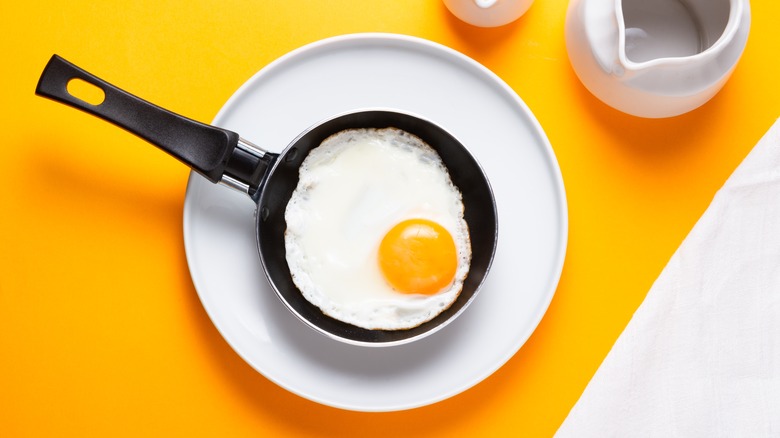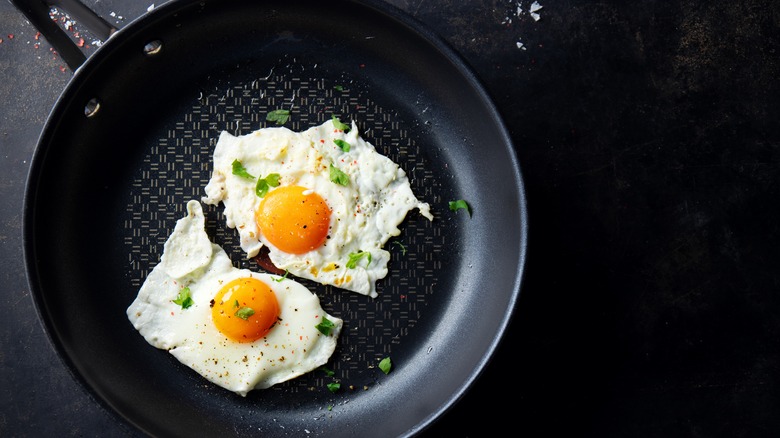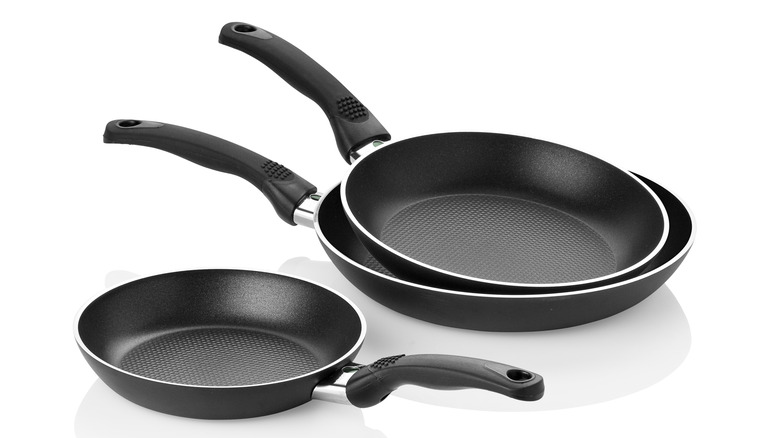Why Nonstick Pans Yield The Best Fried Eggs Every Time
When you're getting ready to zip out the door in the morning, you want breakfast ready and fast. Fried eggs are a delicious and healthy way to start the day, and the best part is they take mere minutes to cook. One way you'll get the perfect fried egg consistently is by using a nonstick pan.
Yes, cast iron and stainless-steel pans also work. But, nonstick has many advantages in keeping those eggs from becoming a scramble. For one, they are a breeze to clean and require very little butter or oil when cooking. And, they are deemed safe. Nonstick cookware is considered safe for everyday cooking, including eggs, as long as temperatures do not exceed 500 degrees Fahrenheit. ( A temperature that high would burn your eggs to a crisp, anyway.)
Nonstick pans heat evenly, are a workhorse in the kitchen, and are a friend to the humble egg. Here's why.
Easy cooking, egg-cellent results
Nonstick pans make it easier to flip and slide the eggs, preventing them from sticking to the surface. This is particularly useful when you want your fried eggs to stay intact and keep that runny yolk unbroken. Since the nonstick coating reduces the likelihood of sticking, you can use less oil or butter when cooking fried eggs. This is beneficial for those looking to reduce their calorie intake or simply prefer lighter cooking.
Nonstick pans provide a consistent and even heat distribution, ensuring that your eggs aren't cooking on hot spots. Even heat is crucial for achieving the desired doneness in your fried egg. Induction and gas stoves both are suited for nonstick pans — but steel-bottomed pans work better on induction cooktops.
Let's not forget about the pesky cleaning afterward. Washing up after cooking eggs is much simpler with a nonstick pan. The smooth surface minimizes the chances of stubborn residues, making it easier to wipe or wash the pan. Do not use harsh scrubbers on the surface, a simple wipe will suffice.
The right nonstick pan
It is not recommended to cook in a peeling nonstick pan. You don't want to ingest any of those flaking Teflon bits. Overheating nonstick pans can also lead to the breakdown of the coating, so stick to stovetop temperatures under 500 degrees Fahrenheit. (Cast iron pans can withstand very high broil temperatures so are better to use in the oven.)
Invest in a high-quality nonstick pan with a smooth surface. An 8 to 12-inch pan is versatile and can be used for many dishes beyond the fried egg such as pancakes, omelets, and delicate fish, where sticking can be an issue. But, if you want a dedicated egg pan, get one that's 6 inches as it is perfect for single egg portions. And, it's cute.
Just remember if you want to make your pan last, avoid using metal utensils that can scratch and damage the nonstick coating. Sound like your mom yet? She's right. If you care for your nonstick pan, you'll be slinging breakfast day after day in no time.


